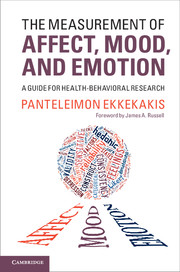Crossref Citations
This Book has been
cited by the following publications. This list is generated based on data provided by Crossref.
Masuyama, Naoki
Islam, Md. Nazrul
and
Loo, Chu Kiong
2014.
Affective communication robot partners using associative memory with mood congruency effects.
p.
1.
Joseph, Stephen
and
Maltby, John
2014.
Positive functioning inventory: initial validation of a 12-item self-report measure of well-being.
Psychology of Well-Being,
Vol. 4,
Issue. 1,
Hammersley, Richard
Reid, Marie
and
Atkin, Stephen L.
2014.
How to measure mood in nutrition research.
Nutrition Research Reviews,
Vol. 27,
Issue. 2,
p.
284.
Longo, Ylenio
2015.
The Simple Structure of Positive Affect.
Social Indicators Research,
Vol. 124,
Issue. 1,
p.
183.
Emerson, Jessica A.
and
Williams, David M.
2015.
The Multifaceted Relationship Between Physical Activity and Affect.
Social and Personality Psychology Compass,
Vol. 9,
Issue. 8,
p.
419.
Rhodes, Ryan E.
and
Kates, Andrew
2015.
Can the Affective Response to Exercise Predict Future Motives and Physical Activity Behavior? A Systematic Review of Published Evidence.
Annals of Behavioral Medicine,
Vol. 49,
Issue. 5,
p.
715.
McConnell, Meghan
and
Eva, Kevin
2015.
Researching Medical Education.
p.
181.
Sala, Margarita
2015.
Post-meal affective states.
Eating and Weight Disorders - Studies on Anorexia, Bulimia and Obesity,
Vol. 20,
Issue. 2,
p.
277.
Loizou, Georgios
and
Karageorghis, Costas I.
2015.
Construction and validation of the circumplex model of affect with English and Greek athletic samples.
International Journal of Sport and Exercise Psychology,
Vol. 13,
Issue. 3,
p.
224.
Masuyama, Naoki
and
Loo, Chu Kiong
2015.
Robotic emotional model with personality factors based on Pleasant-Arousal scaling model.
p.
19.
Lee, Harold H.
Emerson, Jessica A.
and
Williams, David M.
2016.
The Exercise–Affect–Adherence Pathway: An Evolutionary Perspective.
Frontiers in Psychology,
Vol. 07,
Issue. ,
Izmirli, Serkan
and
Kurt, Adile Askim
2016.
Effects of Modality and Pace on Achievement, Mental Effort, and Positive Affect in Multimedia Learning Environments.
Journal of Educational Computing Research,
Vol. 54,
Issue. 3,
p.
299.
Sial, Sara Baber
Sial, Muhammad Baber
Ayaz, Yasar
Shah, Syed Irtiza Ali
and
Zivanovic, Aleksandar
2016.
Interaction of robot with humans by communicating simulated emotional states through expressive movements.
Intelligent Service Robotics,
Vol. 9,
Issue. 3,
p.
231.
Stevens, Courtney J.
Smith, Jane Ellen
and
Bryan, Angela D.
2016.
A pilot study of women’s affective responses to common and uncommon forms of aerobic exercise.
Psychology & Health,
Vol. 31,
Issue. 2,
p.
239.
Kasten, Nadine
and
Fuchs, Reinhard
2016.
Handbuch Stressregulation und Sport.
p.
1.
Lattari, Eduardo
Portugal, Eduardo
Junior, Renato Sobral Monteiro
Oliveira, Bruno Ribeiro Ramalho
Santos, Tony Meireles
Mura, Gioia
Sancassiani, Federica
Murillo-Rodriguez, Eric
Arias-Carrión, Oscar
Budde, Henning
Rocha, Nuno Barbosa
and
Machado, Sérgio
2016.
Acute Affective Responses and Frontal Electroencephalographic Asymmetry to Prescribed and Self-selected Exercise.
Clinical Practice & Epidemiology in Mental Health,
Vol. 12,
Issue. 1,
p.
108.
Phung, Trang Thai Minh
and
Khuong, Mai Ngoc
2016.
The Impact of the Big Five Traits and Mood on Investment Performance A Study of Individual Investors in Vietnam..
SSRN Electronic Journal ,
Starcke, Katrin
Wiesen, Carina
Trotzke, Patrick
and
Brand, Matthias
2016.
Effects of Acute Laboratory Stress on Executive Functions.
Frontiers in Psychology,
Vol. 7,
Issue. ,
Bruun, Anders
Law, Effie Lai-Chong
Heintz, Matthias
and
Eriksen, Poul Svante
2016.
Asserting Real-Time Emotions through Cued-Recall.
p.
1.
Risius, Marten
Akolk, Fabian
and
Beck, Roman
2016.
Mit Social-Media-Stimmungen Börsenkursbewegungen vorhersagen.
Wirtschaftsinformatik & Management,
Vol. 8,
Issue. 3,
p.
74.


